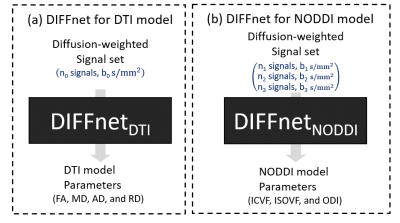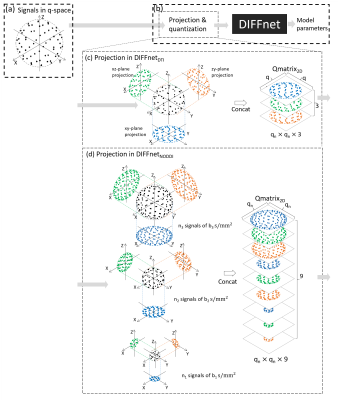Juhyung Park1, Woojin Jung1, Eun-jung Choi1, Se-Hong Oh2, Dongmyung Shin1, Hongjun An1, and Jongho Lee1
1Seoul National University, Seoul, Korea, Republic of, 2Hankuk University of Foreign Studies, Gyeonggi-do, Korea, Republic of
1Seoul National University, Seoul, Korea, Republic of, 2Hankuk University of Foreign Studies, Gyeonggi-do, Korea, Republic of
A
deep neural network was designed to reconstruct the diffusion
parameters from reasonable b-values and gradient schemes. Proposed network
shows highly accurate maps from data with various gradient schemes and b-values
in DTI and NODDI.

Figure 1.
Overview of DIFFnet. Two DIFFnets, one for DTI and the other for NODDI were developed.
(a) For DTI, DIFFnetDTI was constructed to generate DTI parameters
(FA, MD, AD, and RD) from a signal set with diffusion gradient directions and a single
b-value of $$$b_0$$$ s/mm2. (b) For NODDI, DIFFnetNODDI
was designed to generate NODDI model parameters (ICVF, ISOVF, and ODI) from a three-shell signals.
Different from previously proposed networks, DIFFnet does not specify gradient directions and b-values for its input dataset.

Figure 2. Generalized approach
for input gradient directions and b-values via “q-space projection and
quantization”, producing “Qmatrix”. (a) A signal set was placed in a q-space
with q-vectors. (b) Qmatrix was designed via projection and quantization. (c) In
DTI, a signal set was projected on the three planes. Three projected signal sets
were quantized and concatenated, producing a $$$q_n × q_n × 3$$$ matrix. (d) For NODDI, the projection was
performed on each shell. Nine sets of projected signals were generated,
producing a $$$q_n × q_n × 9$$$ matrix. For $$$q_n$$$, 5 to 25 were tested.
